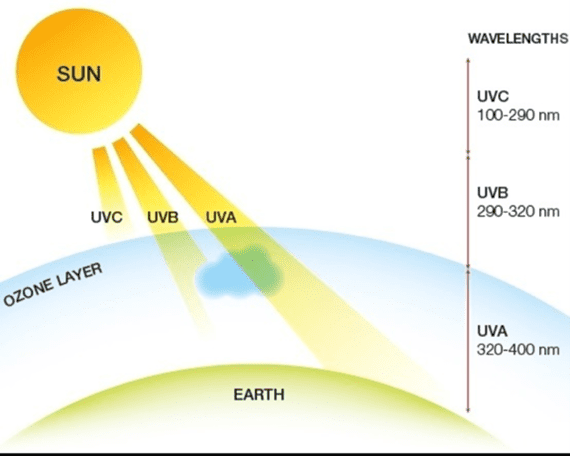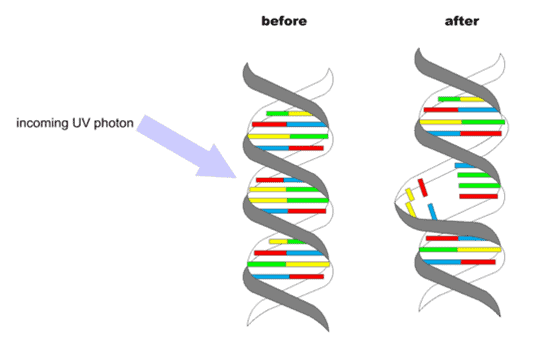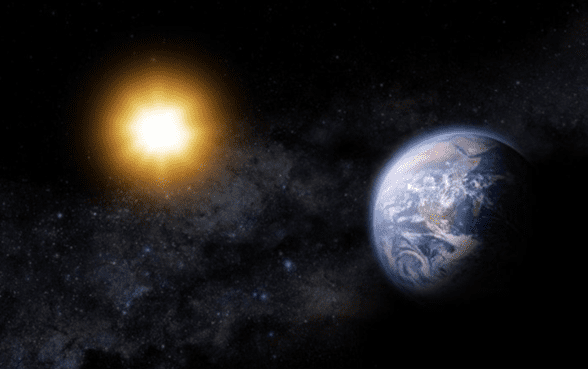Blinded By The Light
Most people are aware of UV-A and UV-B light as it pertains to the sun (and our tan). There are the potential health risks of sun exposure, the need to apply sunscreen to prevent burning, and the potential development of skin cancer. However, a lot of people might not be aware of the individual properties of this invisible light we are exposed to.
UV (ultraviolet) is a is a form of electromagnetic radiation with wavelength from 10 to 400 nm, outside of the visible spectrum of light. UV light ranges from UV-A to UV-C based on the wavelength. Although these forms of UV light are emitted by the sun and other celestial bodies, not all of it makes it to the earth’s surface.
The longer the wavelength of light, the less likely it is to be absorbed by molecules in earth’s atmosphere. UV-A is the longest wavelength of the three. This means that UV-A light can penetrate farthest into tissue and can reach the dermis (middle) layer of skin.

Facts about UV-A:
– Responsible for skin aging and darkening
– Accounts for 95% of of the UV light at Earth’s surface
– This wavelength is 30-50 times more prevalent than UV-B
– UV-B is a shorter wavelength that is mostly absorbed by the ozone layer, and the rays that do pass through the atmosphere can only penetrate the epidermis (the outermost layer) of the skin.
Facts about UV-B:
– UV-B causes more damage to cells and tissue
– This light is the primary cause of skin reddening, sunburns, and leads to the development of skin cancer
– UV-C, the shortest wavelength, does not reach earth’s surface from the sun, and is entirely absorbed by the atmosphere.
Facts about UV-C:
– UV-C based applications use artificial light sources such as UV-C LEDS or mercury lamps
– Unless there is direct, prolonged exposure, UV-C doesn’t pose a serious threat to the skin or eyes
How Does UV-C Kill Pathogens?
UV-C has been used for sanitization for over a century. In 1903 Niels Finsen received the Nobel Prize for his use of UV light as a treatment for tuberculosis of the skin. UV-C is still used to this day as a means of sanitization for water, air, and surfaces, and is used in various industries such as healthcare, HVAC, and food processing.

The mechanism by which UV light is able to kill pathogens is through its mutagenic property-meaning it has the ability to damage and degrade the DNA of living cells-making it an effective germicide. The UV light can break the bonds in DNA and RNA, causing mutations and disruption of cell processes. After enough UV-C exposure, these mutations will cause the genetic code to no longer be able to properly execute vital cell functions.
This means after the CleanSlate’s 20-second, chemical-free sanitization cycle, up to 99.9998% of common germs (such as MRSA and other superbugs) on your device will be dead. This solution brings peace of mind to the user, knowing their device is bacteria free, while also being a major contributor to the control and prevention of harmful infections.
To learn more about CleanSlate UV’s mobile device sanitizing solutions, and what makes CleanSlate UV the most effective tabletop UV-C sanitizer available, please visit our website at www.cleanslateuv.com.


